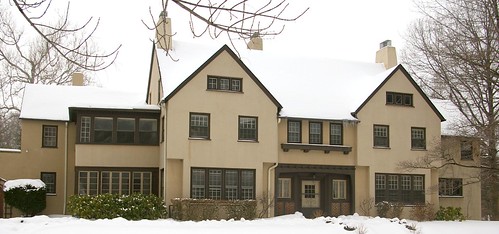The Cuyahoga County Fiscal Officer records and provides various details about each individual residential structure in the county, for the purposes of valuation. Among these is the year that the house was built.
I've often found situations where I was sure that the data was incorrect - there are a lot of houses built in the middle third of the 19th century that list the construction date as "1900" - but I didn't think too heavily about it until I saw the construction date for the James H. Foster residence described as being built in 1920 in this Plain Dealer article.

The house, at 2200 Devonshire Drive, in the historic Ambler Heights neighborhood of Cleveland Heights, was built in 1911. It is the oldest surviving house designed by Walker and Weeks, the Cleveland architectural firm responsible for Public Auditorium, the Federal Reserve Bank of Cleveland, Severance Hall, the Lorain-Carnegie Bridge, and the main building of Cleveland Public Library.
The date used in the Plain Dealer article is the date given by the Cuyahoga County Fiscal Officer. While it is a reasonable approximate for valuing the property - just as much of the rest of the data in their records is a reasonable approximate - it should be taken as this, rather than as a statement of fact.
I wanted to look at just how accurate (or inaccurate) this data, as a whole, might be. I spoke with Kara Hamley O'Donnell, Historic Preservation Planner for Cleveland Heights, who informed me that she has the building permit data for a good chunk of the city. Further, she had an electronic copy of the age data for the Euclid Heights historic district. Here is that data, with my additions in columns I and J - the age given by the County Fiscal Officer and the difference between the two. Note that the structures for which building permit data is present give the month and the day, while data obtained from other sources give only the year, in this data set.
I looked at the County Fiscal Officer's data and present here the first 100 addresses where both building permit data is present and the fiscal officer gives a date. I chose 100 as a nice even number - a bigger sample would probably lend to greater accuracy, as would a random sample. Further, there isn't as much age variablity here as there would be in an area that was built earlier. Still, it's a decent sample, one worth considering.
Of the 100 houses, the fiscal officer has the correct date - the same year as the building permit, or one year later (as construction might continue over the winter) - for only 40% of them. 23% have dates that precede the actual date of construction, while 37% have dates after the actual dates of construction. Most of these have dates within 5 years of what they should be - 23% are off by more than that amount, while 9% are off by more than 10 years.
There are several reasons why the data might be inaccurate. It could be reported incorrectly initially, or have changed when an addition was made. The relatively small difference suggests that there might be some other explanation, one that I'm not yet aware of.
Why does this matter? For the purpose of valuing property, it doesn't. But we need to remember that this is the case. We don't have a great source for age data for the area as a whole. We can come up with good approximates, and based on the age data we have for our houses, we could say that a house was built in "about 1920", but to say that it was built "in 1920" requires more research. And, in this case, it would have revealed the actual date of the construction as 1911.




Funny I should find this today. I just discovered a few days ago, a Plain Dealer article dated from February of 2011that says this this house was being dismantled and demolished to make way for an energy efficient "green" home. I have to see for myself what the new home looks like but I'm sure it's not nearly as gracious and beautifully detailed as this one was.
ReplyDeletehttp://blog.cleveland.com/metro/2011/02/old_cleveland_heights_mansion.html